Add this eBook to your basket to receive access to all 169 records. Our indexes include entries for the spelling bonney. In the period you have requested, we have the following 169 records (displaying 131 to 140): These sample scans are from the original record. You will get scans of the full pages or articles where the surname you searched for has been found. Your web browser may prevent the sample windows from opening; in this case please change your browser settings to allow pop-up windows from this site.  British artillerymen fighting in South Africa
(1899-1902) British artillerymen fighting in South Africa
(1899-1902)
The Queen Victoria's South Africa Medal was awarded (after her death, in the event) to all who had served honourably in the various campaigns in the Boer War. Returns were made from each unit, and consolidated into nominal roll, of which this is the one for the Royal Artillery. Confusingly, the ledgers used had originally been printed for a register of men transferred (or re-transferred after mobilization) to 1st Class Army Reserve. All the original column headings were therefore struck through, and the roll was prepared with this information: Date of Issue; Regimental Number; Rank; Name; Unit; Medal (a 1 indicating that a medal was awarded); [number of] Clasps; the reference to the source in the original returns, usually starting with AG for papers in the hands of the Adjutant-General, and 68/Art/ for the Royal Artillery records. The final column, normally left blank, was occasionally used for explanatory remarks. | Sample scan, click to enlarge
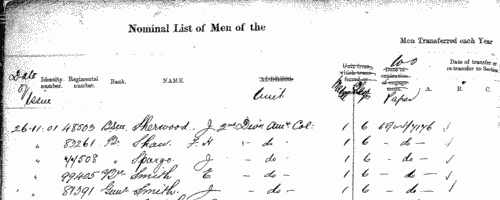
|  Queen's South Africa Medal: Royal Horse Artillery: G Battery
(1901-1905) Queen's South Africa Medal: Royal Horse Artillery: G Battery
(1901-1905)
The nominal roll for the Queen Victoria's South Africa Medal - awarded (after her death, in the event) to all who had served honourably in the various campaigns in the Boer War - was compiled from these returns from the individual units. Two sets of form were completed. The main one, as in the sample scan, dates from 1901 and gives regimental number, rank, and full name (surname first), followed by a series of columns relating to different actions - Belmont, Modder River, Paardeberg, Dreifontein, Wepener, Johannesburg, Diamond Hill, Belfast, Wittebergen, Defence of Kimberley, Relief of Kimberley, Defence of Mafeking, Relief of Mafeking, Cape Colony, Orange Free State, Transvaal, Rhodesia, Talana, Elandslaagte, Tugela Heights, Defence of Ladysmith, Relief of Ladysmith, Laing's Nek, and Natal; each entitled the man to a separate clasp to the medal, and a tick or a Yes in the appropriate column indicates the man's actual physical presence in that battle. A final column for remarks is important in those cases where the man was no longer in the unit, by removal, death or desertion. The second form that sometimes occurs was returned in 1905, and covers men entitled to the Second South African War Medal and Clasps. It lists men by number, rank and name, checks whether they had claimed the Queen's South Africa Medal, and then enquires as to their suitability as to three Colony Clasps, which could be awarded for service in the Cape, Orange Free, or Transvaal; whether entitled to Date Clasps (South Africa 1901 and South Africa 1902); whether also entitled to the King's South Africa Medal; any other corps in which served in South Africa; and remarks (such as becoming non-effective, forfeiture, &c.) WO 100/139 | Sample scan, click to enlarge

|  Queen's South Africa Medal: Royal Horse Artillery: X Battery
(1901-1905) Queen's South Africa Medal: Royal Horse Artillery: X Battery
(1901-1905)
The nominal roll for the Queen Victoria's South Africa Medal - awarded (after her death, in the event) to all who had served honourably in the various campaigns in the Boer War - was compiled from these returns from the individual units. Two sets of form were completed. The main one, as in the sample scan, dates from 1901 and gives regimental number, rank, and full name (surname first), followed by a series of columns relating to different actions - Belmont, Modder River, Paardeberg, Dreifontein, Wepener, Johannesburg, Diamond Hill, Belfast, Wittebergen, Defence of Kimberley, Relief of Kimberley, Defence of Mafeking, Relief of Mafeking, Cape Colony, Orange Free State, Transvaal, Rhodesia, Talana, Elandslaagte, Tugela Heights, Defence of Ladysmith, Relief of Ladysmith, Laing's Nek, and Natal; each entitled the man to a separate clasp to the medal, and a tick or a Yes in the appropriate column indicates the man's actual physical presence in that battle. A final column for remarks is important in those cases where the man was no longer in the unit, by removal, death or desertion. The second form that sometimes occurs was returned in 1905, and covers men entitled to the Second South African War Medal and Clasps. It lists men by number, rank and name, checks whether they had claimed the Queen's South Africa Medal, and then enquires as to their suitability as to three Colony Clasps, which could be awarded for service in the Cape, Orange Free, or Transvaal; whether entitled to Date Clasps (South Africa 1901 and South Africa 1902); whether also entitled to the King's South Africa Medal; any other corps in which served in South Africa; and remarks (such as becoming non-effective, forfeiture, &c.) WO 100/139 | Sample scan, click to enlarge

| Civil Servants and Office Holders
(1910)
The Imperial Calendar gives lists of officials and office-holders throughout England, Wales, Scotland and Ireland
| Sample scan, click to enlarge
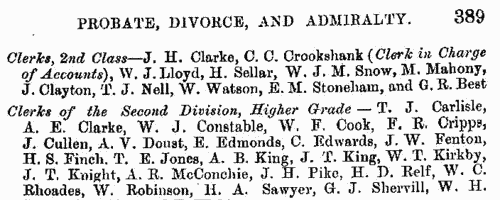
| Members of Durham University
(1910)
The alphabetical list of all living members of Durham University, issued in 1910, was compiled from the Admission Book and University Register. It gives surname, initials, degree, college, and date. Those marked with an asterisk were Members of Convocation. In the case of graduates in Arts, Theology (except in the case of Bachelors of Divinity) and Civil Law, the dates refer to the year in which the examination for the degree of B.A. was passed; in the case of Bachelors of Divinity who were not Graduates in Arts, of Licentiates in Theology, of Civil Engineers, and of Licentiates in Medicine, to the year in which each passed the Final Examination. In the case of Hygiene, Science, and Music, to the year in which the Examination for B.Hy., B.Sc., or B.Mus. was passed; and in the case of Graduates in Medicine to the year in which the Examination for the degree of M.B. was passed, except in the case of practitioners, when the date refers to the year in which the examination for the degree specified was passed. In cases where no date is given the degree is Ad Eundem, unless it is marked honorary. The abbreviations are: Arms., Armstrong College, Newcastle-upon-Tyne; Codr., Codrington College, Barbados; Cos., Bishop Cosin's Hall; F. Bay, Fourah Bay, Sierra Leone; Hatf., Bishop Hatfield's Hall; Med., College of Medicine, Newcastle-upon-Tyne; St. Chad's, St Chad's Hall; St. John's, St John's Hall; Univ., University College. | Sample scan, click to enlarge

| Steam Engine Makers in West Manchester
(1910)
The Steam Engine Makers' Society, a trades union, ended 1910 with 13,401 members in 144 branches. The 86th Annual Report gives a full list of members for each branch, followed by Travelling Expenses subsidised by the branch (with names and dates); Unemployed Expenses (with names and dates); Superannuation, Sick and Funeral Expenses (all with names and dates). | Sample scan, click to enlarge

| Civil Servants and Office Holders
(1913)
The Imperial Calendar gives lists of officials and office-holders throughout England, Wales, Scotland and Ireland
| Sample scan, click to enlarge
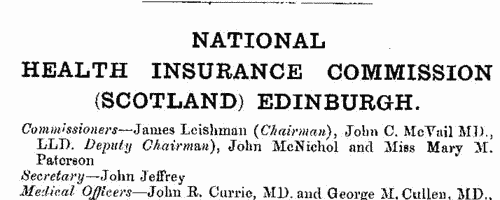
| In police custody at Halifax in Yorkshire
(1923)
The Police Gazette was published by Authority by the London Metropolitan Police, and circulated, as confidential, to the police forces throughout Britain and Ireland. The contents were based on the information routinely submitted to the Criminal Record Office. One of the regular features was a section entitled Persons in Custody, in which each police force gave details of people taken into custody on remand or awaiting trial. The name of the arresting force is given, with duration of remand &c., and nature of charge; then the full name of the suspect (in bold), the C. R. O. number; year of birth; height; complexion; colour of hair; colour of eyes; occupation; birthplace; and details of previous convictions. Variations of surname spelling and aliases are noted in the descriptions, and these variants and aliases have also been indexed. | Sample scan, click to enlarge
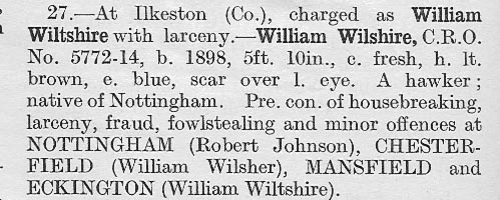
| Medical Practitioners in London
(1926)
The Medical Directory was split into several sections. The London section covered all medical practitioners resident within the London postal district. Each year a schedule was sent to each doctor to be returned to the publishers, so as to keep the directory up to date. In the directory the doctor's name is given first, in bold, surname first, in capitals; then current address. Next are the qualifications; the italic abbreviations in parentheses following the qualifications indicate the medical school at which they were gained. Then there is a list of posts and honours within the profession, starting with those then current; previous posts are preceded by the word 'late'. Finally, brief details are given of any publications. | Sample scan, click to enlarge
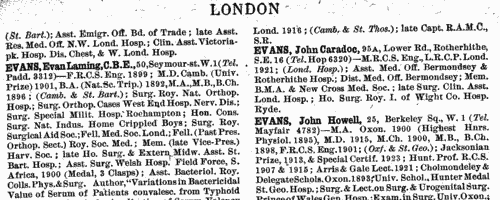
| Medical practitioners qualified in Britain or Ireland but living abroad
(1926)
The Medical Directory was split into several sections. The Practitioners Resident Abroad section covered all medical practitioners who, having qualified in Britain or Ireland or otherwise registered under the medical Acts of Great Britain and Ireland, were living abroad. Each year a schedule was sent to each doctor to be returned to the publishers, so as to keep the directory up to date. In the directory the doctor's name is given first, in bold, surname first, in capitals; then current address. Next are the qualifications; the italic abbreviations in parentheses following the qualifications indicate the medical school at which they were gained. Then there is a list of posts and honours within the profession, starting with those then current; previous posts are preceded by the word 'late'. Finally, brief details are given of any publications. | Sample scan, click to enlarge

|
Research your ancestry, family history, genealogy and one-name study by direct access to original records and archives indexed by surname.
|












